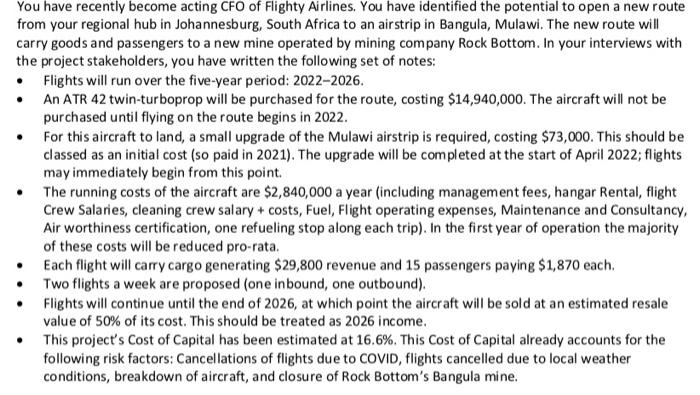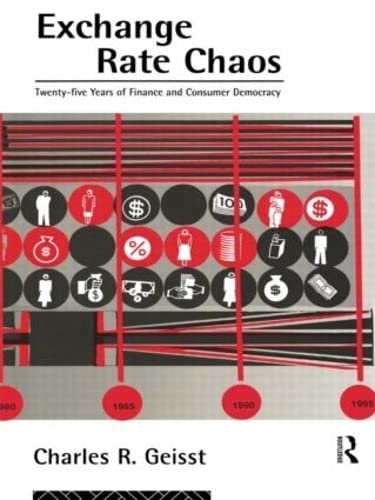You have recently become acting CFO of Flighty Airlines. You have identified the potential to open a new route from your regional hub in Johannesburg, South Africa to an airstrip in Bangula, Mulawi. The new route will carry goods and passengers to a new mine operated by mining company Rock Bottom. In your interviews with the project stakeholders, you have written the following set of notes: Flights will run over the five-year period: 2022-2026. An ATR 42 twin-turboprop will be purchased for the route, costing $14,940,000. The aircraft will not be purchased until flying on the route begins in 2022. For this aircraft to land, a small upgrade of the Mulawi airstrip is required, costing $73,000. This should be classed as an initial cost (so paid in 2021). The upgrade will be completed at the start of April 2022; flights may immediately begin from this point. The running costs of the aircraft are $2,840,000 a year (including management fees, hangar Rental, flight Crew Salaries, cleaning crew salary + costs, Fuel, Flight operating expenses, Maintenance and Consultancy, Air worthiness certification, one refueling stop along each trip). In the first year of operation the majority of these costs will be reduced pro-rata. Each flight will carry cargo generating $29,800 revenue and 15 passengers paying $1,870 each. Two flights a week are proposed (one inbound, one outbound). Flights will continue until the end of 2026, at which point the aircraft will be sold at an estimated resale value of 50% of its cost. This should be treated as 2026 income. This project's Cost of Capital has been estimated at 16.6%. This Cost of Capital already accounts for the following risk factors: Cancellations of flights due to COVID, flights cancelled due to local weather conditions, breakdown of aircraft, and closure of Rock Bottom's Bangula mine. Specific instructions about Part B Part B involves submitting a typed 1-2-page proposal (following a set structure given) and a spreadsheet containing your calculation You should submit these simultaneously by attaching both files to the submission point. You should use pdf for the proposal and xls or xlsx for the spreadsheet. Spreadsheets converted to pdf format will lose all available working marks (as underlying calculations will be lost). Marks are available for mathematics content, presentation, and quality of your proposal and spreadsheet. . You have recently become acting CFO of Flighty Airlines. You have identified the potential to open a new route from your regional hub in Johannesburg, South Africa to an airstrip in Bangula, Mulawi. The new route will carry goods and passengers to a new mine operated by mining company Rock Bottom. In your interviews with the project stakeholders, you have written the following set of notes: Flights will run over the five-year period: 2022-2026. An ATR 42 twin-turboprop will be purchased for the route, costing $14,940,000. The aircraft will not be purchased until flying on the route begins in 2022. For this aircraft to land, a small upgrade of the Mulawi airstrip is required, costing $73,000. This should be classed as an initial cost (so paid in 2021). The upgrade will be completed at the start of April 2022; flights may immediately begin from this point. The running costs of the aircraft are $2,840,000 a year (including management fees, hangar Rental, flight Crew Salaries, cleaning crew salary + costs, Fuel, Flight operating expenses, Maintenance and Consultancy, Air worthiness certification, one refueling stop along each trip). In the first year of operation the majority of these costs will be reduced pro-rata. Each flight will carry cargo generating $29,800 revenue and 15 passengers paying $1,870 each. Two flights a week are proposed (one inbound, one outbound). Flights will continue until the end of 2026, at which point the aircraft will be sold at an estimated resale value of 50% of its cost. This should be treated as 2026 income. This project's Cost of Capital has been estimated at 16.6%. This Cost of Capital already accounts for the following risk factors: Cancellations of flights due to COVID, flights cancelled due to local weather conditions, breakdown of aircraft, and closure of Rock Bottom's Bangula mine. You have recently become acting CFO of Flighty Airlines. You have identified the potential to open a new route from your regional hub in Johannesburg, South Africa to an airstrip in Bangula, Mulawi. The new route will carry goods and passengers to a new mine operated by mining company Rock Bottom. In your interviews with the project stakeholders, you have written the following set of notes: Flights will run over the five-year period: 2022-2026. An ATR 42 twin-turboprop will be purchased for the route, costing $14,940,000. The aircraft will not be purchased until flying on the route begins in 2022. For this aircraft to land, a small upgrade of the Mulawi airstrip is required, costing $73,000. This should be classed as an initial cost (so paid in 2021). The upgrade will be completed at the start of April 2022; flights may immediately begin from this point. The running costs of the aircraft are $2,840,000 a year (including management fees, hangar Rental, flight Crew Salaries, cleaning crew salary + costs, Fuel, Flight operating expenses, Maintenance and Consultancy, Air worthiness certification, one refueling stop along each trip). In the first year of operation the majority of these costs will be reduced pro-rata. Each flight will carry cargo generating $29,800 revenue and 15 passengers paying $1,870 each. Two flights a week are proposed (one inbound, one outbound). Flights will continue until the end of 2026, at which point the aircraft will be sold at an estimated resale value of 50% of its cost. This should be treated as 2026 income. This project's Cost of Capital has been estimated at 16.6%. This Cost of Capital already accounts for the following risk factors: Cancellations of flights due to COVID, flights cancelled due to local weather conditions, breakdown of aircraft, and closure of Rock Bottom's Bangula mine. Specific instructions about Part B Part B involves submitting a typed 1-2-page proposal (following a set structure given) and a spreadsheet containing your calculation You should submit these simultaneously by attaching both files to the submission point. You should use pdf for the proposal and xls or xlsx for the spreadsheet. Spreadsheets converted to pdf format will lose all available working marks (as underlying calculations will be lost). Marks are available for mathematics content, presentation, and quality of your proposal and spreadsheet. . You have recently become acting CFO of Flighty Airlines. You have identified the potential to open a new route from your regional hub in Johannesburg, South Africa to an airstrip in Bangula, Mulawi. The new route will carry goods and passengers to a new mine operated by mining company Rock Bottom. In your interviews with the project stakeholders, you have written the following set of notes: Flights will run over the five-year period: 2022-2026. An ATR 42 twin-turboprop will be purchased for the route, costing $14,940,000. The aircraft will not be purchased until flying on the route begins in 2022. For this aircraft to land, a small upgrade of the Mulawi airstrip is required, costing $73,000. This should be classed as an initial cost (so paid in 2021). The upgrade will be completed at the start of April 2022; flights may immediately begin from this point. The running costs of the aircraft are $2,840,000 a year (including management fees, hangar Rental, flight Crew Salaries, cleaning crew salary + costs, Fuel, Flight operating expenses, Maintenance and Consultancy, Air worthiness certification, one refueling stop along each trip). In the first year of operation the majority of these costs will be reduced pro-rata. Each flight will carry cargo generating $29,800 revenue and 15 passengers paying $1,870 each. Two flights a week are proposed (one inbound, one outbound). Flights will continue until the end of 2026, at which point the aircraft will be sold at an estimated resale value of 50% of its cost. This should be treated as 2026 income. This project's Cost of Capital has been estimated at 16.6%. This Cost of Capital already accounts for the following risk factors: Cancellations of flights due to COVID, flights cancelled due to local weather conditions, breakdown of aircraft, and closure of Rock Bottom's Bangula mine









